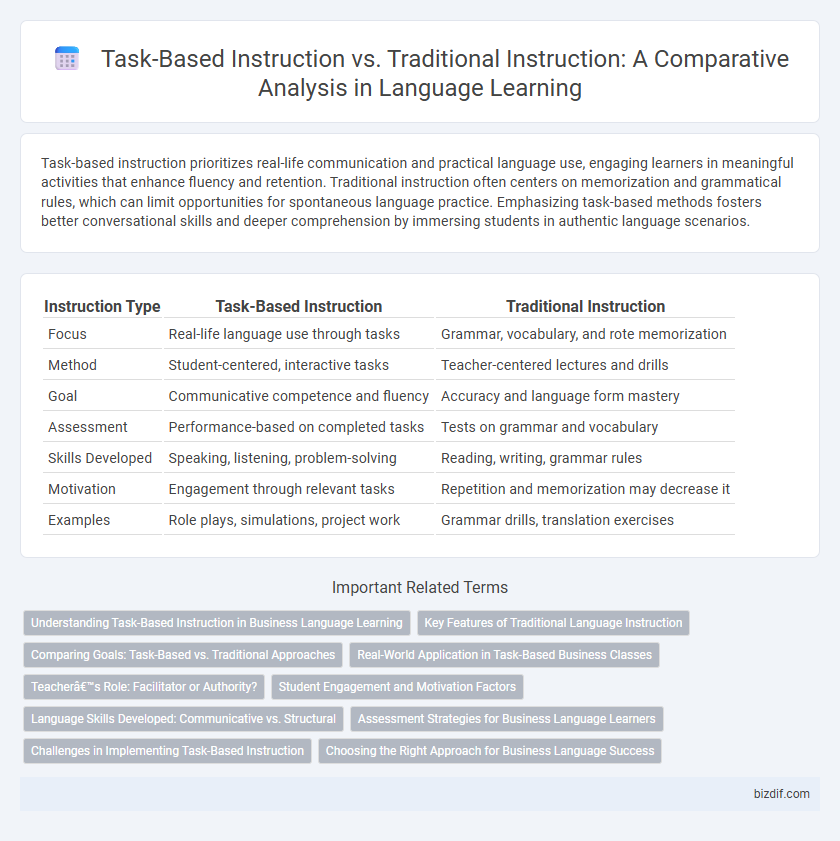Task-based instruction prioritizes real-life communication and practical language use, engaging learners in meaningful activities that enhance fluency and retention. Traditional instruction often centers on memorization and grammatical rules, which can limit opportunities for spontaneous language practice. Emphasizing task-based methods fosters better conversational skills and deeper comprehension by immersing students in authentic language scenarios.
Table of Comparison
| Instruction Type | Task-Based Instruction | Traditional Instruction |
|---|---|---|
| Focus | Real-life language use through tasks | Grammar, vocabulary, and rote memorization |
| Method | Student-centered, interactive tasks | Teacher-centered lectures and drills |
| Goal | Communicative competence and fluency | Accuracy and language form mastery |
| Assessment | Performance-based on completed tasks | Tests on grammar and vocabulary |
| Skills Developed | Speaking, listening, problem-solving | Reading, writing, grammar rules |
| Motivation | Engagement through relevant tasks | Repetition and memorization may decrease it |
| Examples | Role plays, simulations, project work | Grammar drills, translation exercises |
Understanding Task-Based Instruction in Business Language Learning
Task-based instruction in business language learning centers on practical communication skills through real-world tasks, enhancing learner engagement and contextual understanding. Unlike traditional instruction, which emphasizes grammar rules and rote memorization, task-based methods prioritize meaningful interaction and problem-solving relevant to business scenarios. This approach boosts retention and fluency by simulating authentic workplace communication, thereby directly supporting professional language competence.
Key Features of Traditional Language Instruction
Traditional language instruction emphasizes grammar rules, vocabulary memorization, and repetitive drills to build language accuracy. It typically follows a teacher-centered approach, focusing on reading, writing, and translation exercises. The method prioritizes explicit correction and structured lessons over spontaneous communication or real-life language use.
Comparing Goals: Task-Based vs. Traditional Approaches
Task-based instruction prioritizes communicative competency by engaging learners in meaningful real-world tasks, whereas traditional instruction emphasizes grammatical accuracy and rote memorization. The primary goal of task-based methods is to develop practical language use through problem-solving and interaction, contrasting with the traditional focus on mastering explicit linguistic rules. This shift in objectives reflects a broader pedagogical move towards learner-centered education that values functional language skills over static knowledge.
Real-World Application in Task-Based Business Classes
Task-based instruction in business language classes prioritizes real-world application by engaging students in authentic communication tasks, such as negotiating contracts or drafting emails, which directly replicate professional scenarios. Unlike traditional instruction, which often emphasizes grammar and vocabulary in isolation, task-based learning promotes practical language use and problem-solving skills essential for workplace success. This approach enhances learners' ability to apply language effectively in dynamic business environments, fostering fluency and confidence.
Teacher’s Role: Facilitator or Authority?
In task-based instruction, the teacher acts as a facilitator, guiding students through interactive activities that promote authentic language use and learner autonomy. Traditional instruction positions the teacher as an authority figure who directs lessons, controls content delivery, and focuses on explicit grammar and vocabulary teaching. This shift from authority to facilitation enhances student engagement and practical language application in real-world contexts.
Student Engagement and Motivation Factors
Task-based instruction significantly enhances student engagement and motivation by involving learners in meaningful, real-world activities that require active participation and problem-solving. In contrast, traditional instruction often relies on rote memorization and passive learning, which can lead to diminished interest and lower intrinsic motivation. Research shows that task-based methods increase interaction, autonomy, and confidence, resulting in higher levels of sustained student motivation and improved language acquisition outcomes.
Language Skills Developed: Communicative vs. Structural
Task-based instruction enhances communicative language skills by engaging learners in real-life tasks that promote practical usage and interaction. Traditional instruction primarily focuses on structural language skills, emphasizing grammar rules, vocabulary, and sentence construction through rote memorization. Emphasizing communicative competence in task-based methods leads to improved speaking, listening, and fluency compared to the accuracy-oriented outcomes of traditional approaches.
Assessment Strategies for Business Language Learners
Task-based instruction employs authentic, performance-oriented assessments that measure business language learners' ability to complete real-world tasks such as writing reports and conducting meetings, fostering practical language application. Traditional instruction typically relies on standardized tests and rote memorization, emphasizing grammar and vocabulary accuracy rather than communicative competence in business contexts. Effective assessment strategies for business language learners prioritize task completion and situational language use to better prepare learners for professional environments.
Challenges in Implementing Task-Based Instruction
Implementing task-based instruction in language teaching faces challenges such as the need for extensive teacher training to design and facilitate authentic, communicative tasks effectively. Limited classroom time and large class sizes often hinder personalized interaction and meaningful task completion. Resistance to shifting from traditional grammar-focused methods to a more student-centered, task-oriented approach further complicates implementation efforts.
Choosing the Right Approach for Business Language Success
Task-based instruction emphasizes real-world communication through practical tasks tailored to specific business contexts, enhancing language retention and workplace applicability. Traditional instruction focuses on grammar rules and vocabulary drills, which may limit fluency and conversational confidence in dynamic professional settings. Selecting task-based methods boosts engagement and relevancy, driving measurable improvement in business language proficiency and intercultural competence.
Task-based instruction vs Traditional instruction Infographic

 bizdif.com
bizdif.com